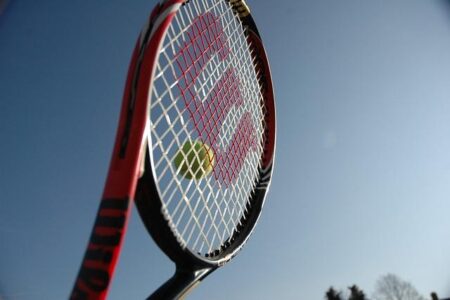Wimbledon Dress Code Dispute: Rising‚Äč Star Faces Unusual ‚ÄĆScrutiny
In an unexpected turn of‚Äč events at teh renowned Wimbledon tournament,a ‚Äćpromising tennis player found herself ‚Ā£embroiled in a heated debate over the‚ÄĆ event’s dress code. Officials reportedly requested that she lift her skirt to confirm adherence ‚ÄĆto the tournament’s ‚Äčstringent attire regulations, igniting widespread ‚Ā£discussion about the appropriateness and implications of such oversight. ‚ÄčAs attention from the tennis community intensifies, this ‚Äćincident prompts essential inquiries into personal expression, tradition, ‚Ā£and evolving standards for sportswear at one of the most celebrated events in athletics. This article explores the details surrounding ‚Ā§this encounter,reactions from both the athlete and broader tennis community,as well‚Äč as it’s‚Ā§ implications for dress codes in professional‚Äć sports.
Wimbledon’s Dress Code Controversy Exposes Strict ‚ÄĆNorms for ‚ĀĘFemale Athletes
The recent episode involving a notable female‚ÄĆ competitor at Wimbledon has reignited conversations regarding‚Ā£ the ‚ĀĘtournament’s rigid ‚ĀĘdress code‚ÄĒone that many believe disproportionately impacts women. In an incident that drew meaningful backlash and‚Äć disbelief,‚Äč officials asked her to lift her ‚ÄĆskirt to ensure compliance‚ÄĆ wiht Wimbledon‚Äôs‚Äč notorious all-white policy enforced by The All England Club. This event underscores how excessively strict rule enforcement can overlook athletes’ comfort and ‚ĀĘautonomy.
The conventional dress code at Wimbledon is steeped in history; however, its enforcement often appears overly severe. Critics argue that several factors highlight‚ÄĆ an ‚Äćurgent need for reform regarding how these guidelines are applied:
- Gender disparity: The intense scrutiny faced by female players often contrasts sharply with more lenient standards imposed on their male counterparts.
- Public‚ĀĘ Image: such incidents contribute to narratives that undermine women’s professionalism within sports.
- Athlete Comfort: Stringent attire requirements can lead to discomfort‚Ā£ or distraction during competition.
| Aspect | Male ‚ÄĆCompetitors | Female Competitors |
|---|---|---|
| Dress Code Adaptability | Lax regulations | Tight restrictions |
| Sparse enforcement |
Gender‚Ā£ Disparities in Sports Attire Policies and Their Impact
The renewed focus on gender disparities within sports attire policies has ‚ĀĘemerged following instances ‚Ā£where female athletes have faced unreasonable scrutiny over their clothing choices. The‚ĀĘ case involving a player at Wimbledon being ‚Ā§asked to lift her skirt illustrates ‚ĀĘa larger issue affecting ‚Äčwomen across various athletic disciplines. Regulations dictating what female competitors must wear can undermine their performance capabilities while infringing upon their dignity and autonomy. At its core lies an outdated notion suggesting women’s bodies should conform ‚ÄĆto antiquated ideals rather than emphasizing‚ÄĆ their athletic prowess.
The ramifications of these dress‚ÄĆ codes extend beyond‚Äč individual athletes; they reverberate throughout sporting culture ‚Äćas well. Consider these ‚ÄĆpotential impacts:
- Mental Pressure: Female competitors may ‚ÄĆbecome preoccupied or ‚ÄĆself-conscious about their appearance instead of‚ĀĘ concentrating on‚Ā£ gameplay.
- Pervasive Exclusionary Practices:This rigidity ‚Äčmay deter ‚ÄĆyoung girls from engaging with sports altogether,
perpetuating cycles of underrepresentation.
‚ĀĘ
| Aspect | Male Sports | Female Sports |
|---|---|---|
| Attire Freedom | < td >Greater options available < td >Strict norms often outdated||
Proposals for Evolving Dress Code Regulations in Tennis
The recent ‚Ā§situation involving‚ÄĆ scrutiny over a‚ÄĆ player’s outfit has raised vital questions concerning current dress code regulations within‚Ā§ tennis.
It is indeed clear these rules‚ÄĒfrequently enough rooted deeply in‚ĀĘ tradition‚ÄĒmay not‚Äć align with contemporary ‚Äćvalues surrounding‚Ā£ professionalism or personal expression.To cultivate a more inclusive atmosphere,
governing bodies should consider implementing several key changes:
- < strong>Diverse Attire Policies ‚Äć: < strong>Create Gender-Neutral Standards :< strong Establish uniform guidelines applicable across genders , promoting equality.< li />< strong>Prioritize Comfort & Performance :< strong Focus on fabrics/designs enhancing athlete‚Äć comfort/performance , especially under varying weather conditions .< li />< strong>Cultivate ‚Ā£Inclusivity & Diversity :< strong Encourage designs catering diverse cultural backgrounds/athletic needs , reflecting sport‚Äôs varied participants/fans .< li />
Alongside revising attire regulations ,
it is crucial also establish‚ĀĘ transparent consultation ‚Ā£processes engaging players/coaches/stakeholders‚ĀĘ directly‚Äč affected .
By forming committees dedicated towards addressing such matters ,
governing bodies could gather‚Äć insights directly from those impacted by existing policies .
Potential outcomes might include:
| <‚Äč b>Proposed Change</b>< >Expected Outcome</b>< / tr‚Ā£ >/thead /tr /> / tbody‚ÄĆ | /tr /> / tbody | /table>
Add A Comment |
|---|






